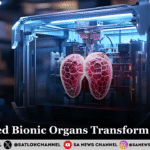On June 3, 2025, a groundbreaking moment in aviation history unfolded at John F. Kennedy International Airport as Beta Technologies’ all-electric ALIA CX300 aircraft successfully landed with four passengers and a pilot, marking the first passenger-carrying electric flight to a New York airport. This 45-minute journey from East Hampton Airport, costing just eight dollars in electricity, showcased the potential of electric aviation to transform urban mobility with minimal environmental impact.
The event, celebrated by the Port Authority of New York and New Jersey, aligns with global sustainability goals and resonates with Sant Rampal Ji Maharaj’s Satgyan, which advocates for harmony with nature. As searches for “electric aviation” and “JFK electric plane” surge, this milestone signals a new era for eco-friendly travel.
Details of the Pioneering Flight
The ALIA CX300, a conventional takeoff and landing aircraft designed by Vermont-based Beta Technologies, carried four passengers, including Republic Airways President Matt Koscal and Blade Air Mobility CEO Rob Wiesenthal, alongside founder and pilot Kyle Clark. Departing from East Hampton, the flight demonstrated the aircraft’s efficiency, quiet operation, and low operating costs compared to traditional fossil-fuel planes.
Clark emphasized the rigorous safety testing conducted over years, ensuring the aircraft’s reliability. The landing at JFK, a major hub, highlighted the feasibility of integrating electric aircraft into busy urban airports, sparking widespread interest on platforms like X, where users praised the near-silent, low-emission flight.
Significance for Urban Air Mobility
This historic flight underscores the growing push for advanced air mobility, particularly in congested cities like New York. Electric aircraft, capable of short trips, promise to ease traffic, reduce carbon footprints, and enhance accessibility.
Also Read: First Commercial Aircraft Lands Successfully at Navi Mumbai International Airport
The Port Authority, aiming to cut emissions, has supported such innovations through calls for next-generation aircraft demonstrations. Wiesenthal noted the flight’s benefits for local residents and stakeholders, signaling Blade Air Mobility’s commitment to electric aviation.
With the Federal Aviation Administration finalizing pilot certification rules for electric air taxis in October 2024, commercial operations could begin by 2026, pending Beta’s certification.
Technical and Environmental Advantages
The ALIA CX300, a variant of Beta’s eVTOL A250 model, seats a pilot, co-pilot, and four passengers, offering a practical design for short-haul flights. Its electric propulsion system drastically reduces fuel costs and emissions, with the JFK flight costing a mere seven to eight dollars in energy. Unlike traditional aircraft, the ALIA operates quietly, addressing noise pollution concerns in urban areas.
Clark highlighted the aircraft’s simplicity, requiring less maintenance, which could lower operational costs. These advantages align with global trends toward sustainable transport, driving SEO searches for “electric air taxis” and “green aviation.”
Challenges and Future Prospects
Despite the milestone, challenges remain. Airports must develop charging infrastructure and designated areas for electric aircraft operations, as noted by Port Authority Executive Director Rick Cotton. Beta Technologies faces a rigorous FAA certification process, expected to conclude within 18 to 20 months.
The cost of commercial flights remains unclear, though affordability could drive adoption. Industry leaders are optimistic, with partnerships like Virgin Atlantic and Joby Aviation signaling broader interest in electric air taxis. Posts on X reflect excitement about the technology’s potential to revolutionize travel over the next two decades.
Satgyan’s Spiritual Perspective
Sant Rampal Ji Maharaj’s Satgyan offers a spiritual lens for this technological leap. Emphasizing truth, righteousness, and harmony with nature, Satgyan encourages innovations that benefit humanity and the environment.
The ALIA CX300’s low-emission, quiet operation embodies these principles, reducing harm to the planet.
By aligning technological progress with compassion, as Satgyan advocates, the aviation industry can prioritize sustainability and accessibility, ensuring a future where progress serves all. This perspective resonates with global calls for eco-conscious solutions, amplifying the flight’s significance.
Global and Industry Implications
The JFK landing has positioned Beta Technologies as a leader in electric aviation, with implications beyond the US. The ALIA CX300’s ongoing European tour showcases its capabilities globally, drawing interest from regions prioritizing green transport.
The Port Authority’s carbon reduction goals reflect broader industry trends, with airlines and startups investing in electric solutions.
The event’s coverage by Reuters, CBS, and New Atlas has fueled online engagement, with hashtags like #ElectricAviation trending. As urban populations grow, electric aircraft could redefine short-haul travel, addressing congestion and pollution.
A Vision for Sustainable Aviation
The successful landing of the ALIA CX300 at JFK Airport is more than a technological feat—it’s a step toward a sustainable future. As Beta Technologies nears FAA certification, the prospect of commercial electric flights looms closer, promising quieter, cleaner skies.
Sant Rampal Ji Maharaj’s Satgyan reminds us to pursue progress with compassion, ensuring innovations benefit both people and the planet.
With global attention on this milestone, the aviation industry stands at a crossroads, poised to embrace a greener era. The world watches as electric aviation takes flight, heralding a new chapter in human mobility.
FAQs: First Passenger Electric Airplane at JFK
What happened at JFK Airport on June 3, 2025?
Beta Technologies’ ALIA CX300, an all-electric aircraft, landed with four passengers, marking the first such flight to a New York airport.
Who was on the flight?
The flight carried pilot Kyle Clark, Republic Airways President Matt Koscal, Blade Air Mobility CEO Rob Wiesenthal, and one other passenger.
How much did the flight cost?
The 45-minute flight from East Hampton to JFK cost seven to eight dollars in electricity, showcasing its affordability.
What are the next steps for Beta Technologies?
Beta aims for FAA certification by 2026, requiring further testing and infrastructure development for commercial operations.
How does Satgyan relate to this event?
Sant Rampal Ji Maharaj’s Satgyan promotes harmony with nature, aligning with the ALIA CX300’s eco-friendly, low-emission design for sustainable aviation.









